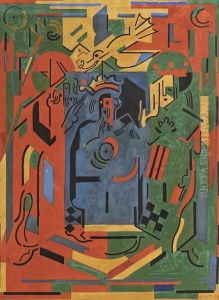Alfred Gleizes Paintings
Albert Gleizes was a French artist, theoretician, philosopher, a self-proclaimed founder of Cubism and an influence on the School of Paris. Born in Paris on December 8, 1881, he was initially a member of the Section d'Or group of artists. Gleizes's early work reflects an interest in the late Impressionism movement, with the vibrant light and color playing a significant role in his paintings. However, his style evolved rapidly towards a more radical approach to form and technique, which culminated in his involvement in the development of Cubism.
Gleizes's involvement with Cubism began around 1910 when he met other like-minded artists such as Jean Metzinger, with whom he wrote 'Du Cubisme' in 1912, one of the first major treatises on the new artistic movement. His paintings from this period, such as 'La Femme aux Phlox' (1910) and 'Man on a Balcony' (1912), exhibit the fragmentation of form and multiple perspectives characteristic of Cubist artwork. During this time, he also played a critical role in organizing the Salon de la Section d'Or in 1912, which was the most significant Cubist exhibition prior to World War I.
When World War I broke out, Gleizes served in the military but continued to paint when he could. His work from this period began to show a departure from the strict tenets of Cubism, as he became more interested in incorporating rhythm and broader, more dynamic forms into his work, a phase sometimes referred to as 'Crystal Cubism'. After the war, Gleizes became increasingly involved in the social implications of art and was a proponent of the concept of 'Art for Society'. He delved into writing and teaching, spreading his ideas on art, spirituality, and society.
In the following decades, Gleizes continued to develop his artistic style and theoretical approach. He experimented with nonrepresentational art and incorporated elements of abstraction into his work. His art from the 1920s and beyond shows a persistent exploration of rhythm, volume, and space.
Gleizes remained active in the artistic community throughout his life, writing, painting, and engaging in discourse on the nature and purpose of art. He died on June 23, 1953, in Avignon, France. His legacy includes not only his contributions to the early development of Cubism but also his extensive theoretical work and his influence on subsequent generations of artists.
